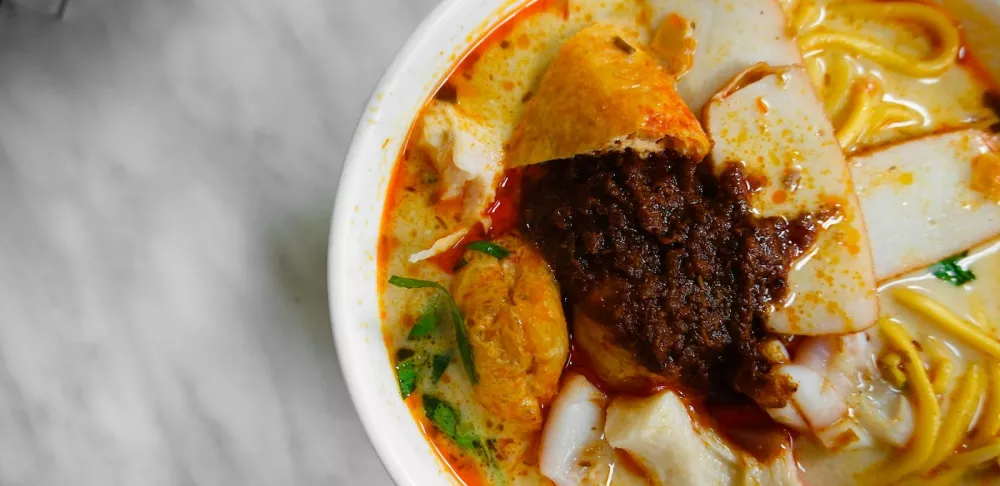Laksa, a tantalizing and aromatic noodle soup dish, has captured the hearts and taste buds of people across Southeast Asia and beyond.
While it is renowned for its rich and spicy flavors, few may realize that laksa noodle soup is a culinary wonder born from the fusion of Chinese and Malay traditions within the vibrant Peranakan culture.
It's essential to understand the Peranakan community, often referred to as the Baba-Nyonya or Straits Chinese, before delving into the origin of the laksa noodle dish. The term "Peranakan" means "descendants" or "born of" in Malay, bringing emphasis to the mixed heritage of this unique ethnic group. The Peranakans are the descendants of Chinese immigrants who settled in the historic Straits Settlements of Southeast Asia, including regions such as Penang, Malacca, Singapore and parts of Indonesia, primarily during the Ming and Qing dynasties.
Over time, these Chinese settlers intermarried with local Malays and Indonesians, resulting in a distinctive cultural and ethnic group that harmoniously blended elements of both Chinese and Southeast Asian cultures. The Peranakans have their own language, customs, traditions, art forms and, of course, cuisine.
This cuisine became known as Nyonya cuisine.
What is Nyonya Cuisine?
Also known as Peranakan or Straits Chinese cuisine, Nyonya recipes serve as a testament to the rich blend of Chinese and Malay culinary traditions both sides of the community have brought together. The cuisine is well known for its bold and intricate flavors, often involving a plethora of aromatic herbs, spices and indigenous ingredients combined with the culinary techniques from both sides.
Nyonya dishes are known for their perfectly balanced sweet, sour, salty and spicy flavors, creating many wonderfully fulfilling dishes including the mouth-watering laksa noodle dish.
How is Laksa Prepared?
One of the key components that gives laksa its distinctive flavor is a spice paste known as "rempah." Serving as the flavor base for the rich and fragrant broth that defines laksa's taste, the specific composition of the rempah can vary depending on regional variations and personal preferences. It typically includes ingredients such as shallots, garlic, ginger, lemongrass, chile peppers and often belacan (shrimp paste). These ingredients are finely chopped, ground or blended together to create a fragrant spice paste that can be saved in batches for many different Nyonya dishes outside of laksa.
To prepare laksa, the rempah is sautéed or cooked in oil until it becomes aromatic, releasing its full range of flavors. Coconut milk is then added to create a creamy and hearty broth. Various other ingredients like noodles, protein (such as prawns, chicken or tofu), bean sprouts and sometimes hard-boiled eggs are added to complete the dish.
More Noodles: An Introduction to Common Types of Chinese Noodles
The use of rempah in laksa is instrumental in giving the soup its complexity, spiciness and depth of flavor. The ingredients in rempah draw from both Chinese and Malay culinary traditions, reflecting the fusion of these culinary influences within the Peranakan culture. Chinese elements such as ginger, garlic and shallots harmonize with Malay elements like lemongrass, chile peppers, coconut milk and shrimp paste to create a unique and piquant spice paste that forms the heart of laksa noodle soup.
One of the wonderful aspects of laksa noodle soup is its diversity. Although Nyonya laksa may have been its origin, there are several regional variations of the dish, each with its own unique twist, including:
- Laksa Lemak: Known for its rich and heavy coconut milk-based broth, which is creamier and more savory-forward than laksa Nyonya.
- Laksa Asam: Featuring a tangy tamarind-based broth that offers a delightful contrast to the spiciness.
- Laksa Johor: Utilizes spaghetti-like flour noodles instead of the traditional rice or wheat noodles.
These variations highlight the diversity of laksa across different cultural influences over time while still maintaining the original heart of the dish that was born from the love of two distinct peoples that came together, making it a historic and cherished dish.
Other Nyonya cuisine staples include:
- Ayam Pongteh: a chicken stew braised in a thick, savory sauce made from fermented soybean paste and palm sugar.
- Ikan Assam Pedas: a sour, spicy fish stew infused with tamarind juices and chile peppers.
- Kuih Pie Tee: a crispy tart filled with a mixture of vegetables, seafood and a sweet and spicy chile sauce.
- Otak-otak: a type of fish cake made from spiced fish paste and coconut milk that is wrapped in banana leaves and steamed.
- Popiah: spring rolls filled with expertly cut vegetables, prawns and sometimes eggs, served with a sweet and spicy chile sauce.
Although these Nyonya dishes may not be as easily recognizable as laksa, they are just as delicious and important to the heritage of this blended cuisine.
Laksa noodles and Nyonya cuisine as a whole represent a beautiful and harmonious fusion of culinary traditions within the Peranakan culture. This unique blend of flavors, drawing from ingredients rooted in both Chinese and Malay culinary heritage, exemplifies the richness and creativity of Nyonya cuisine.
It showcases the coexistence of diverse flavors and culinary techniques that were born between the love of a migrant culture to a new land and its local people, resulting in beloved dishes like laksa noodle soup that continue to captivate foodies around the world.
More Noodle History: An Introduction to Common Types of Japanese Noodles




